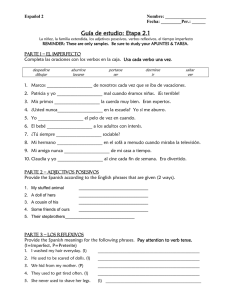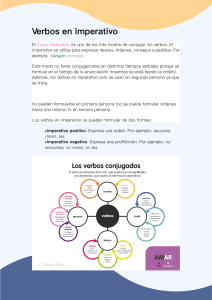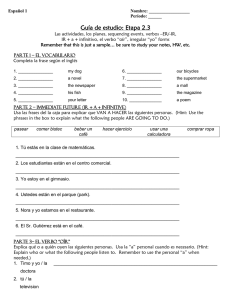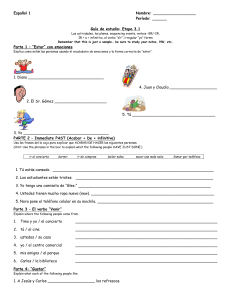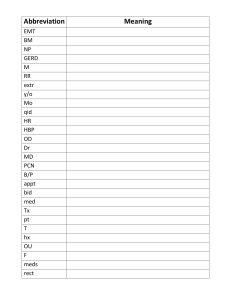Espa-ñ-ol 332
advertisement
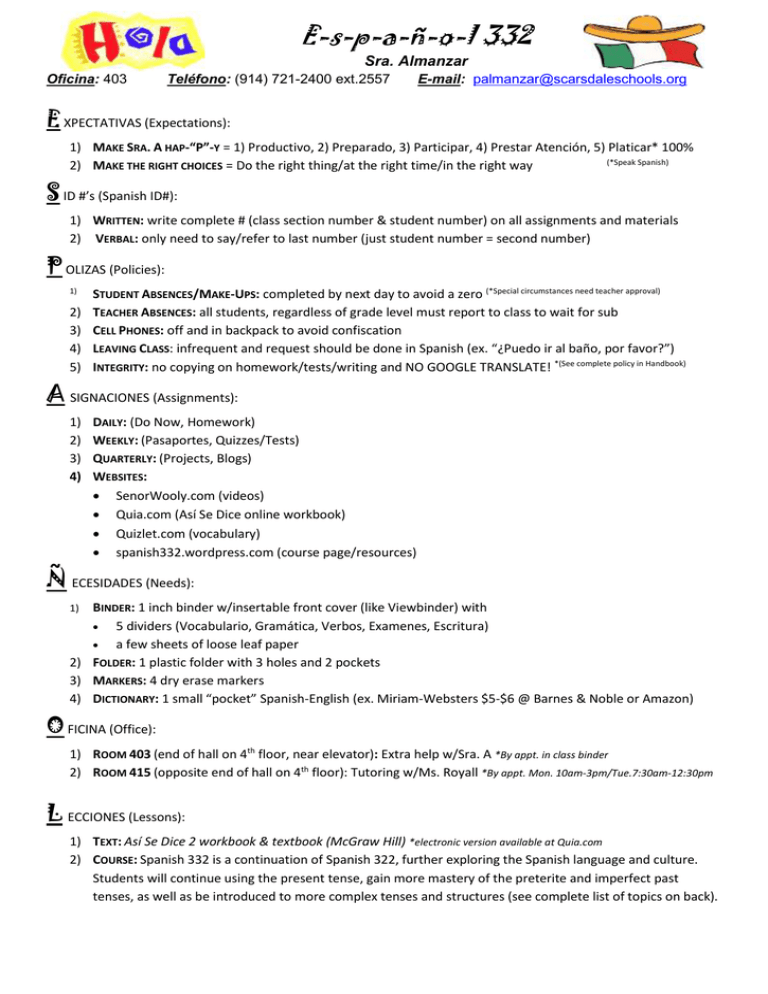
E-s-p-a-ñ-o-l 332 Sra. Almanzar Oficina: 403 Teléfono: (914) 721-2400 ext.2557 E-mail: palmanzar@scarsdaleschools.org E XPECTATIVAS (Expectations): 1) MAKE SRA. A HAP-“P”-Y = 1) Productivo, 2) Preparado, 3) Participar, 4) Prestar Atención, 5) Platicar* 100% (*Speak Spanish) 2) MAKE THE RIGHT CHOICES = Do the right thing/at the right time/in the right way S ID #’s (Spanish ID#): 1) WRITTEN: write complete # (class section number & student number) on all assignments and materials 2) VERBAL: only need to say/refer to last number (just student number = second number) P OLIZAS (Policies): 1) 2) 3) 4) 5) STUDENT ABSENCES/MAKE-UPS: completed by next day to avoid a zero (*Special circumstances need teacher approval) TEACHER ABSENCES: all students, regardless of grade level must report to class to wait for sub CELL PHONES: off and in backpack to avoid confiscation LEAVING CLASS: infrequent and request should be done in Spanish (ex. “¿Puedo ir al baño, por favor?”) INTEGRITY: no copying on homework/tests/writing and NO GOOGLE TRANSLATE! *(See complete policy in Handbook) A SIGNACIONES (Assignments): 1) 2) 3) 4) DAILY: (Do Now, Homework) WEEKLY: (Pasaportes, Quizzes/Tests) QUARTERLY: (Projects, Blogs) WEBSITES: SenorWooly.com (videos) Quia.com (Así Se Dice online workbook) Quizlet.com (vocabulary) spanish332.wordpress.com (course page/resources) Ñ ECESIDADES (Needs): BINDER: 1 inch binder w/insertable front cover (like Viewbinder) with 5 dividers (Vocabulario, Gramática, Verbos, Examenes, Escritura) a few sheets of loose leaf paper 2) FOLDER: 1 plastic folder with 3 holes and 2 pockets 3) MARKERS: 4 dry erase markers 4) DICTIONARY: 1 small “pocket” Spanish-English (ex. Miriam-Websters $5-$6 @ Barnes & Noble or Amazon) 1) O FICINA (Office): 1) ROOM 403 (end of hall on 4th floor, near elevator): Extra help w/Sra. A *By appt. in class binder 2) ROOM 415 (opposite end of hall on 4th floor): Tutoring w/Ms. Royall *By appt. Mon. 10am-3pm/Tue.7:30am-12:30pm L ECCIONES (Lessons): 1) TEXT: Así Se Dice 2 workbook & textbook (McGraw Hill) *electronic version available at Quia.com 2) COURSE: Spanish 332 is a continuation of Spanish 322, further exploring the Spanish language and culture. Students will continue using the present tense, gain more mastery of the preterite and imperfect past tenses, as well as be introduced to more complex tenses and structures (see complete list of topics on back). Así Se Dice 2 (Spanish 332): *Course will continue where left off from last year REVIEW OF PREVIOUS YEAR: Lecciones Preliminares: A. Amigos, Alumnos, y Parientes B. En Casa y En La Escuela C. Personalidad y Salud D. Los Deportes E. ¡Vamos De Compras! F. De Vacaciones Capítulo 1: En Avión a. Presente de hacer, poner, traer, salir b. El presente progresivo c. Pronunciación: la consonante “r” Capítulo 2: Una Rutina Diferente a. b. c. d. Verbos reflexivos Verbos reflexivos de cambio radical Mandatos con “favor de” Pronunciación: la “h,” la “y,” y la “ll” Capítulo 3: En Tren a. Pretérito de los verbos irregulares b. El verbo decir c. Pronombres después de una preposición Capítulo 4: En El Restaurante a. Presente de los verbos de cambio radical e b. Pretérito de los verbos de cambio radical e c. Adjetivos de nacionalidad d. La voz pasiva con “se” Capítulo 5: ¿Qué Se Celebra? a. Imperfecto de los verbos en –ar b. Imperfecto de los verbos en –er, -ir c. Imperfecto de los verbos irregulares d. Usos del imperfecto Capítulo 6: Tecnomundo a. Verbos como querer, creer en el pasado b. El pretérito y el imperfecto c. Dos acciones pasadas en la misma frase CONTINUATION: Capítulo 7: En El Hotel a. El presente perfecto b. Participios irregulares c. Dos complementos “me lo,” “te lo,” “nos lo” d. Dos complementos con “se” Capítulo 8: Ciudad y Campo a. Futuro de los verbos regulares b. Futuro de los verbos irregulares c. Los pronombres con el infinitivo y el gerundio Capítulo 9: ¿Vas En Carro? a. Imperativo familiar – formas regulares b. Imperativo familiar – formas irregulares c. El condicional Capítulo 10: Cocina Hispana a. El subjuntivo b. El imperativo formal c. El imperativo familiar – formas negativas Capítulo 11: ¡Cuídate Bien! a. El subjuntivo con expresiones impersonales b. “¡Ojalá! ,” “¡Quizás!,” “¡Tal vez!” c. El subjuntivo de los verbos de cambio radical d. Comparación de igualdad i i, o u

